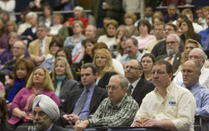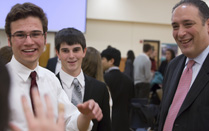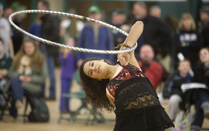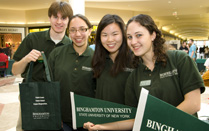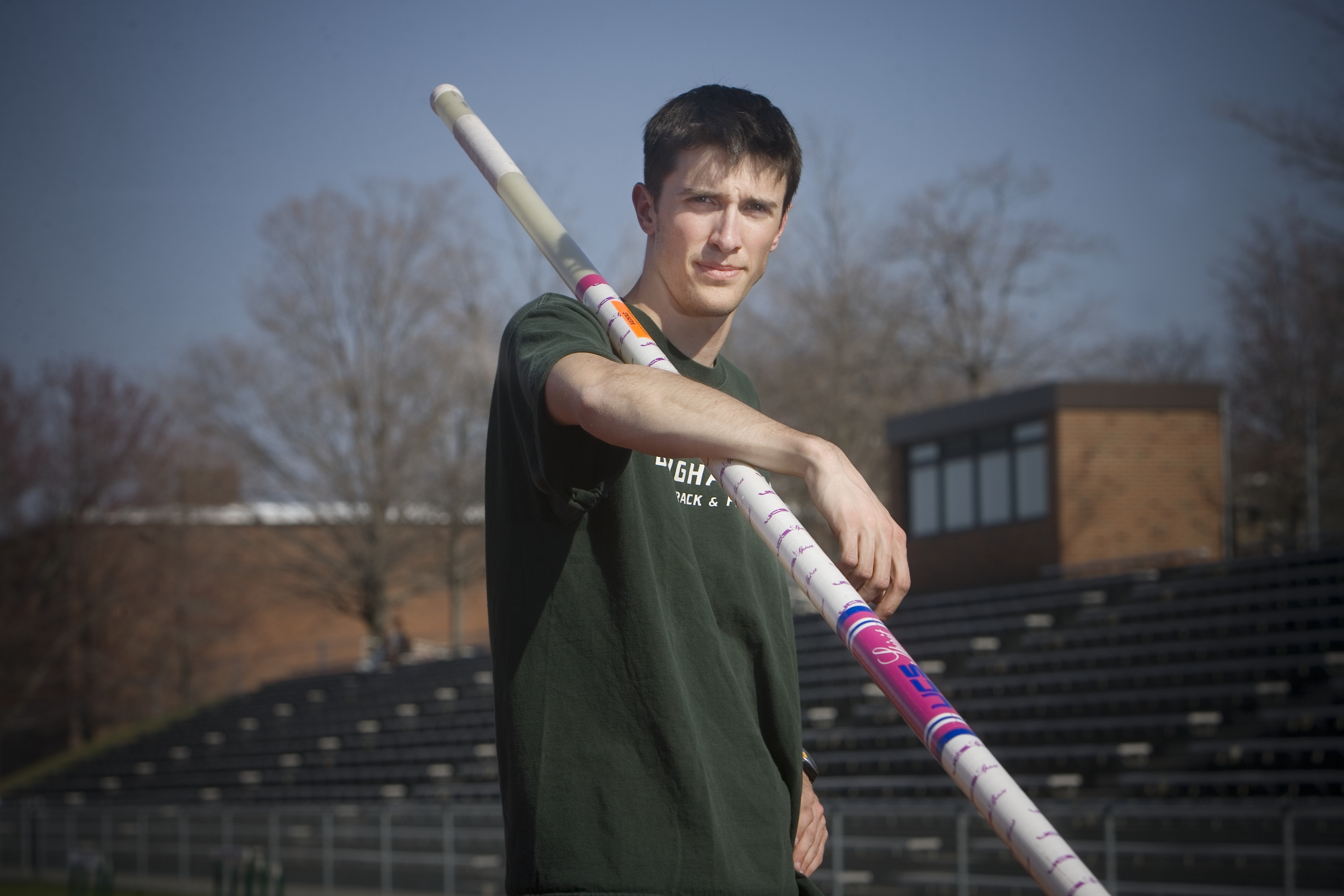Binghamton University President Harvey Stenger's quarterly report - March 31, 2013
As some of you know, my favorite stress-reducer is running and I’ve learned as I navigate Vestal’s steep hills that you have to keep your eye on the path ahead of you, and that speed is not everything — strength and stamina are equally important when trying to finish your run.
Looking at the University’s achievements over the past three months tells me that the campus seems to have a natural understanding of these lessons. We’ve nearly completed the Road Map that will set us on the path to becoming the premier public; we’ve worked to build on our strengths in undergraduate and graduate education; and we’re hiring faculty in a range of disciplines that will ensure academic excellence for the long haul. Because of these efforts, Binghamton University’s reputation and visibility continue to rise.
As you click through the divisional pages in this quarter’s report, you will see that the entire campus has been deeply invested in enhancing our core academic mission. This quarter we’ve seen changes in the Educational Opportunity Program (EOP) that will strengthen its Summer Enrichment Program, record-setting academic achievements by our student athletes, a student-organized TEDx conference that sold out the Anderson Center’s Osterhout Concert Theater, building renovations that will allow for more laboratory and classroom space, and the appointment of an experienced interim dean for the Graduate School, among many other achievements.
Binghamton’s commitment to academic and scholarly excellence continues to attract attention. Our faculty are being recognized in national publications and online media for innovative research, and we have once again set a new high for total freshman, transfer and graduate student applications. And for the first time, a Binghamton University student has been awarded a prestigious Gates Cambridge Scholarship. Psychology graduate Natalia Chapovalova ’12, will represent our campus among only 39 U.S. scholars chosen for this honor. Her achievements, and the quarterly accomplishments of the entire University, help bring recognition for Binghamton and place us well on the path to becoming the premier public university.
Like everyone else on campus, I have been very busy over the past three months. My duties over this period have generally fallen into three general areas:
• administration and planning
• working with SUNY and community leaders to strengthen education and enhance regional economic opportunities
• increasing the University’s visibility and effectiveness within the region, within SUNY and around the world
Administration and planning
Much of my time has been spent working on the Road Map and communicating about our future to the campus, legislators, alumni, friends and supporters in the larger community.
In January, the vice presidents and I held our annual State of the University meeting. Lecture Hall 1 was packed with an audience made up primarily of faculty and staff, as my senior staff discussed some of the divisional highlights for 2012 (many of which have been documented in these quarterly reports) and described how their divisions will be implementing NYSUNY 2020. In my talk, I described how this landmark legislation has provided impetus and support for the Road Map. In addition, it has highlighted the importance of economic development as part of the University’s mission, particularly regarding the University’s involvement with the Southern Tier Economic Development Council, which is now gearing up for a third round of state funding. The council, established by Gov. Andrew Cuomo in 2011, provides support for projects that bring together businesses, academia and governmental and non-profit organizations to stimulate economic growth and job creation.
Of course, underlying all of the discussion in the State of the University messages was the ongoing Road Map process, which is now nearing the implementation stage. Developing the Road Map has been a long but productive process. As the new year began, Provost Donald Nieman, and I, with input from the Road Map Steering Committee, ranked the 176 proposals we received from the nine Road Map Teams. All of these proposals were the product of serious and thoughtful reflection about the University and its future, and I want to thank everyone who participated. As strong as these proposals were, it was clear to us that not all of them could be immediately funded or supported. In the end, the Steering Committee identified 46 that would immediately be implemented; over the next two years the University will focus more than $13.37 million in support of these projects.
We’ve organized these proposals into five strategic areas that emerged from the proposals themselves; each of these answers completes the sentence: “The premier public university of the 21st century will . . .
• engage in path-breaking, graduate education, research, scholarship and creative activities that shape the world;
• provide a transformative learning community that prepares students for advanced education, careers and purposeful living.
• unite to foster a diverse and inclusive campus culture;
• enhance the University’s economic, social and cultural impact through engagement from the local to the global level;
• and optimize the acquisition and allocation of human, technological, financial and physical resources;
Each of the vice presidents has identified proposals that they will be championing and will develop implementation plans, budgets, benchmarks and milestones that will help us track our progress as we move down the road to becoming the premier public. The provost and I, along with members of the communications team, are preparing the final version of the document for public launch in the Mandela Room at 4 p.m. Monday, April 8. We hope to see you there.

With educational and scholarly excellence as the foundation for our Road Map, it is vital that the University also has strong academic leaders. The University is pleased to announce the appointment of Anne McCall as the new dean of Harpur College of Arts and Sciences. A scholar of 19th-century French literature and, for the past five years, dean of arts, humanities and social sciences at the University of Denver, McCall will assume her duties on Aug. 1, 2013. Before becoming dean at the University of Denver, McCall taught at Vassar College and Tulane University. She is the recipient of Tulane’s Excellence in Undergraduate Teaching Award and is a past president of the George Sand Association. Her background in the liberal arts and sciences, her experiences in international education and her extensive leadership experience are very impressive. I think she is just the person to make a great college even better.
In addition, Nancy Stamp has recently stepped down from her duties as dean of the Graduate School; Distinguished Service Professor of English Susan Strehle serving as interim vice provost and dean while a national search for a permanent replacement proceeds. This is actually Strehle’s second stint at this job — she served as vice provost and dean of the Graduate School from 1993-2000 and as interim dean of the Graduate School of Education in 2007-08.
Support for SUNY initiatives
As University president, I frequently interact with the SUNY system leaders in Albany. I recently was appointed to serve on the SUNY Shared Service Committee, which was first established in 2011. The committee is charged with identifying areas where the system’s 64 campuses can work collaboratively by sharing essential services, particularly those that can be easily conducted online (such as shared data networks) or where two or more campuses are regionally located so that students, faculty and staff can easily commute between campuses. The goal of the committee is to identify duplicative services and identify best practices in order to reduce administrative costs. SUNY Chancellor Nancy Zimpher believes that shared services could ultimately save the system as much as $100M annually, funds that will be shifted toward direct instruction and student services while promoting system-wide consistencies in services.
For example, Binghamton University is already is a member of the Campus Alliance Network, which targets administrative collaboration in areas such as administrative leadership, information technology and human resources. We also are considering participation in STAR-NY, a system-wide online tutoring program. In addition, the Binghamton Advantage Program, which allows for joint admissions between Broome Community College and Binghamton University, was touted at the January committee meeting as a model for other campuses to emulate.
The University is also playing a role in SUNY’s efforts to increase the utilization of Minority and Women Owned Business Enterprises (MWBE). Binghamton has adopted a range of approaches to address this issue, including vender and campus outreach where campus employees work with MWBEs to help them gain knowledge about and certification for state procurement opportunities. We also have worked with campus departments and divisions to encourage them to seek out MWBEs when contracting for goods and services. As a result, nearly 15 percent of all our external contracts have been awarded to MWBEs (nearly triple our previous rate) and we are close to meeting the 20 percent target established by SUNY in 2012. We share SUNY’s conviction that working with MWBEs will significantly add to our region’s economic growth and strengthen our community.
Also in the past quarter I have been appointed a member of the Research Foundation Board of Directors. This state-wide agency manages and oversees the externally sponsored research at all SUNY campuses. I am looking forward to participating in this important voluntary, independent and self-perpetuating board that is composed of researchers, campus and system administrators, and representatives of business and industry.
Advocacy and international collaboration
We’ve been working to raise the profile of the University regionally, across the state and internationally. Nearly 50 student groups, college and school representatives, and University staff were on hand for the fourth annual Binghamton University Day at the Oakdale Mall on Feb. 23. The event attracted hundreds of local shoppers who stopped by to view performances by student groups ranging from African drumming and Indian dance to Japanese sword performance. Younger children and their parents were encouraged to participate in hands-on craft projects and view science demonstrations and exhibits of research conducted by students through our Undergraduate Research Center. Visitors were especially interested in the Thomas J. Watson School of Engineering and Applied Science Baja Buggy and the NASCAR vehicle shown by driver Brent Cross and his team of Watson School interns. Advocacy day at the mall has become a staple of our local outreach and highlights many of the ways the University impacts the local community while generating interest among young people who might someday attend the University.
More than 60 faculty, staff, students and community members traveled to Albany on March 5, to meet with members of the New York state legislature and their staffs as part of our annual Binghamton University Advocacy Day. This year we focused many of our discussions on the directions our Road Map is taking us and the important role that the University plays in terms of regional economic development and community vitality.
The senators and assembly members were especially interested in hearing about our plans for the University’s future, including the development of the High Tech Incubator in downtown Binghamton, the potential establishment of a new pharmaceutical sciences and pharmacy school and the focus on smart-energy research as part of the NYSUNY 2020 plan. Advocacy teams shared with our political leaders the importance of NYSUNY 2020 in terms of providing a solid fiscal foundation for future growth and development and expressed our appreciation for their continuing support of Binghamton University. Advocacy Day involves groups from all across the campus, and I especially want to thank the representatives from our professional union (UUP) and service employees union (CSEA) for their involvement.
Finally, my wife Cathy and I spent the past couple of weeks traveling to Korea and China with Vice President for Research Bahgat Sammakia, Watson School Dean Hari Srihari, Associate Professor of Mechanical Engineering S.B. Park and Daryl Santos, professor and director of the Integrated Electronics Engineering Center (IEEC). We met with leaders of LG Healthcare, Samsung Displays and Samsung Techwin, with the goal of developing research partnerships and internship opportunities for students. We also visited KAIST University in Daejeon, Korea, where we discussed enhancements to our current student exchange program and increasing research collaboration. But the personal highlight of our trip to Korea was the reception we received from a group of Binghamton alumni in Seoul, where we discussed the future of the University and our desire to strengthen connections with our international graduates.
In Beijing, China, we met with the directors of the Hanban, which oversees the Confucius Institutes; our Confucius Institute of Chinese Opera is one of the centerpieces of our Asian and Asian-American program on campus. We also traveled to Zhenjiang International School, where we met with students who will be attending Binghamton next fall.
This international travel on behalf of the University is very exciting and promises a brighter future for the University. Of course, the jet lag and constant movement of this visit also reminded me of one of the other lessons I’ve learned from running through the campus in the morning: sometimes you just have to stop and enjoy the scenery!
Sincerely,

Harvey G. Stenger

